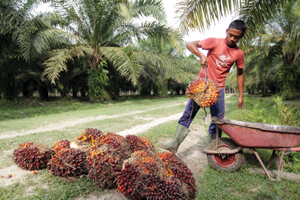CQ WEEKLY – VANTAGE POINT
May 19, 2012 – 10:41 a.m.
Failing the Biofuels Grade
By Nathan Hurst, CQ Staff
When is a biofuel just not “bio” enough? Much to the chagrin of soybean farmers in the United States and palm oil producers in Asia and Africa, the answer depends not just on what makes the fuel but also on who’s tallying the toll on the environment.

|
||
|
The Environmental Protection Agency is the subject of the palm oil producers’ ire; they’re stung by regulators’ decision to exclude the tropical vegetable fat from being used as part of the Renewable Fuel Standard program. Promulgated in 2007, the RFS regulations are best known for bringing E-10 — or gasoline blended with up to 10 percent ethanol, generally made from corn or soybeans — to fuel pumps across the nation.
But the renewable mandate’s current goal, to bring 15.2 billion gallons of biofuels to the U.S. energy supply this year and 36 billion gallons in another decade, won’t be achieved by corn and soybeans alone.
Plus, ethanol isn’t the only flora-based fuel out there. As it turns out, palm oil — a reddish, solid-at-room-temperature lipid common to African and Asian cuisines — also makes a mean biodiesel, one that investors in countries such as Indonesia and Malaysia are hoping to cash in on.
Already they have sunk millions of dollars into clearing rain forest to expand palm plantations with the goal of boosting production capacity in hopes of capturing at least some of the mandated fuel market in the United States and European Union. And in Congress, two New Jersey Democrats, Sen.
But being made of plant material doesn’t offer Earth-friendly certitude. The EPA demands that a biofuel make at least a 20 percent improvement over fossil fuel in “life cycle greenhouse gas emissions,” meaning how much pollution the fuel yields from its growth in a field to burning it in an engine. And the EPA reported in January that palm oil didn’t quite make the cut, maxing out at a 17 percent improvement over regular gasoline. Malaysia’s minister of plantation industries and commodities, Bernard Giluk Dompok, says the math doesn’t add up. Last month, he told his country’s New Straits Times that in making the 17 percent determination, the EPA “did not take into consideration recent oil palm yield improvements and environmental protection development undertaken by our planters, millers and refiners.”
Dompok’s disappointment hasn’t gone unnoticed; his government and others have hired Washington lobbyists to cajole the EPA into reversing its rule. They ended up getting an extended comment period, to April 27, which itself yielded more controversy. Environmental groups such as the Union of Concerned Scientists urged the EPA to hold its ground on palm oil, arguing that the government studies underestimated the environmental toll from palm oil production.
That should have been good news for U.S. soybean producers, who have been boosted in recent years by the renewable-fuels mandate. But they, in fact, are locked in their own battle against European regulators who say soybean-based fuel doesn’t quite meet the EU’s own emissions standards for renewable fuels, which require a 35 percent improvement over fossil fuels.
European regulators say U.S. soybean fuels eke out only a 31 percent improvement — good enough for the United States, but not for Europe. The United Soybean Board insists that its fuel ranges between 39 percent and 49 percent, and, like the Malaysian palm oil producers, it is lobbying for a change. The board has asked federal officials here to convince the EU that if soybean fuel is good enough for the United States, it’ll be good enough for Europe.
In the meantime, though, palm oil producers will keep their sights — and lobbying dollars — trained on the EPA, hoping a change of heart here might help make inroads for palm oil sales in Europe. It’s an uphill battle against both regulators: The EPA’s own initial findings say use of palm fuel “would lead to significant releases of [greenhouse gases] to the atmosphere,” language that’s unlikely to trump the EU’s 35 percent mandate for improvement.